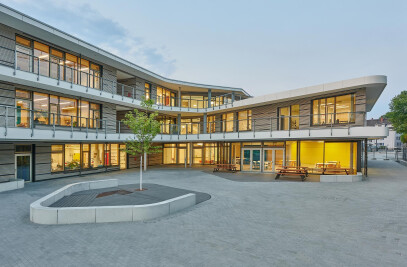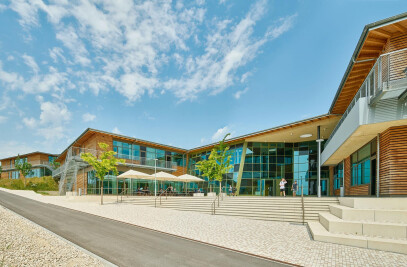The new home of the John and Frances Angelos Law Center unites classrooms, faculty offices, administrative space, and the law library under a single roof for the first time in the history of the school. The building, located at the prominent intersection of Mount Royal Avenue and Charles Street, functionally & symbolically defines the Law School as an academic & social nexus, offering state-of-the-art teaching and learning facilities while fostering an interactive, communicative environment for collaboration between students, faculty, and administrators.
With the proximity of the site to Baltimore’s principal train station, Penn Station; at the terminus of one of Baltimore’s great urban thoroughfares; and immediately adjacent to the Jones Falls Expressway, this building also creates an important and highly visible threshold to the campus and the City, and demonstrates the commitment of the University of Baltimore to the on-going renewal and development of the city.
Architectural Design The building form consists of three interlocking L-shaped volumes which articulate the functions of the building program – classrooms and offices, the legal clinic, and the law library – and define a narrow atrium, a “green stalk” rising up through the heart of the building and connecting the three volumes. In addition to its function as the connective tissue between program spaces, the atrium also captures the lobby, two coffee bars (forum level and Level 6) and informal work and meeting spaces. An Appellate Moot Court for practice court hearings, lectures and events is located one floor down from the main lobby and a garden level “forum” space for informal public events gives onto an exterior sunken garden on the north side of the building. This garden, shielded from the noise of the expressway to the north by a concrete retaining wall and water feature, creates a new urban link between Oliver Street to the west and the new moot court green roof to the east. Setbacks in the building massing created by the volumetric composition create occupiable planted roof terraces at varying levels on all four sides of the building that take advantage of the building’s height relative to the surrounding neighborhood to provide views out over the city of Baltimore.
The atrium is critical to both the technical performance of the building as well as to furthering the social and pedagogical goals of the Law School. It works with generous exterior and interior wall glazing in conjunction with shallow floor plates to maximize daylight autonomy and visual access to daylight for interior work spaces, while simultaneously providing a transparent and communicative interior, visually linking public space, teaching space, and administrative space in an open and inspiring environment. Glazed office partitions transmit daylight entering the exterior wall through the office and into interior corridors and shared space, reducing the artificial lighting demand. Glazed classroom partitions create visual continuity between teaching spaces and public areas and animate the atrium with the scholastic life of the school.
Due to varied requirements for floor-to-floor heights of the various program elements, and in order to provide appropriate ceiling heights in each of the space types, the floor slabs in each of the volumes are staggered vertically over the height of the building. Floors with offices have appropriate heights for offices, and floors with classrooms have appropriate heights for classrooms, creating a dynamic building section in which views from one side of the atrium to the other interconnect over multiple floors. The two sides of the atrium are connected with a series of stairs and ramps that allow people to walk leisurely between floors of the building, interact informally with their colleagues and fellow students, and view the various activities of the law school that line the space.
The building exterior is clad with three distinct façade types – the office/classroom façade, the library façade, and the atrium façade. The office/classroom façade is a glazed aluminum unitized wall, with alternating punched window openings and solid aluminum plate units. Punched windows include sections of operable window, ensuring that all office and classroom spaces have access to natural ventilation, and all glazed openings are fully shaded on the exterior using automated venetian blinds that can be positioned to fully block solar penetration to the building interior, but remain open in the top one-third of the window height in order to admit natural light simultaneously. Protecting these exterior blinds is a frameless glass screen wall, supported by outrigger brackets from the façade. This glass rain screen protects the shading from high winds in the upper stories and serves to unify the reading of the primary volumes that constitute the building parti. The second façade type is the library façade, also a glazed aluminum unitized curtainwall, however in this case all of the units are glass that is treated with varying types of ceramic frit that altogether cover approximately seventy percent of the wall, protecting the interior from solar gain. One-half of the panels are fully fritted, and the other half are coated with a custom gradient frit that alternates a half-floor height every other panel, creating a three dimensional ‘woven’ effect. Alternating panels have operable awning-style vents to introduce natural ventilation into the library spaces. The third façade type, the atrium façade, is an all-glass multi-story curtainwall supported on a steel frame that spans between the building volumes. Operable flaps at each floor level introduce automated natural ventilation into the atrium and serve as make-up air inlets for the smoke exhaust system.
Sustainability The John and Frances Angelos Law Center is the first large-scale opportunity for the University to demonstrate its intent to pursue strategies that eliminate global warming emissions and achieve climate neutrality. Anticipated to achieve LEED Platinum status, the building utilizes a number of closely-integrated strategies to achieve a 43% energy cost savings over an ASHRAE 90.1-2004 baseline building, with an annual site energy use intensity of 40 kBtu/sf (approximately 125 kWh/m² annually). The climate concept responds both to varying programmatic requirements and Baltimore’s humid summer climate, moderate intermediate seasons, and moderate winters. A structurally-integrated heating and cooling system (radiant water tubing embedded in the 11” deep concrete structural slab) is coupled with a hybrid ventilation system as the primary interior conditioning approach. The radiant slab system maintains the massive concrete structure at a stable temperature, while a low-volume dedicated outdoor air system with enthalpy wheel heat recovery provides ventilation when outdoor conditions are not favorable for natural ventilation. Teaching spaces with higher internal heat gains utilize a displacement ventilation system delivered at floor level. Ventilation air is transferred from perimeter spaces to the atrium via customized air transfer devices that maintain acoustical and fire separation between diverse program spaces. Occupants have local control of operable windows in all office, teaching and library spaces, and are notified of favorable outdoor conditions by means of a green light next to the operating switch. Atrium operable windows are fully controlled by the building automation system based on favorability of outdoor conditions.
Other notable sustainable features include: - LED lighting throughout, minimizing energy consumption and extending maintenance life dramatically over conventional fixtures. - Flexibly-located, freestanding direct/indirect LED floor lamps for all office illumination - Over 70 custom-designed LED “butterfly” chandeliers that populate the atrium space - Green roofs on all outdoor terraces which capture rainwater and direct it to a 25,000 gallon rainwater harvesting tank, where it is repurposed for toilet flushing and interior irrigation needs. - Sustainable interior finish materials – linoleum, bamboo, FSC-certified wood, recycled-content concrete, Green Label Plus carpeting

































